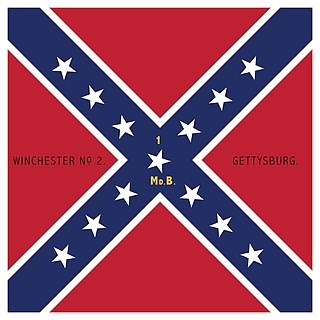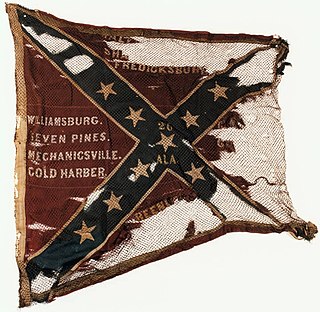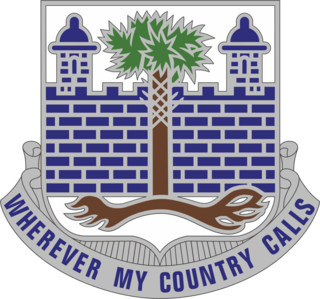The 201st Field Artillery Regiment is a West Virginia Army National Guard regiment. It currently perpetuates the Virginia elements of the Maryland and Virginia Rifle Regiment, which fought in the American Revolution. Organized by Colonel Morgan Morgan in Bunker Hill, West Virginia in 1735, it is one of the oldest continually-active regiments in the U.S. Army, and the oldest unit in the West Virginia Army National Guard. Units also saw action on both sides of the American Civil War, with many companies of the regiment combined to form the Union Army's 1st West Virginia Infantry.

Hampton's Legion was an American Civil War military unit of the Confederate States of America, organized and partially financed by wealthy South Carolina planter Wade Hampton III. Initially composed of infantry, cavalry, and artillery battalions, elements of Hampton's Legion participated in virtually every major campaign in the Eastern Theater, from the first to the last battle.

The 22nd Virginia Infantry Regiment was an infantry regiment from the western Virginia that served in the Confederate States Army during the American Civil War. Its commander was George S. Patton Sr., the grandfather of World War II General George S. Patton.

The 26th Virginia Infantry Regiment was an infantry regiment raised in Virginia for service in the Confederate States Army during the American Civil War. It fought mostly with the Army of Northern Virginia and in South Carolina.

The 26th Virginia Infantry Battalion was a unit of the Confederate States Army organized on May 20, 1862 from men of the 59th Virginia Infantry Regiment who were not captured at the Battle of Roanoke Island and additional companies of recruits. It was commanded by Lt. Col. George M. Edgar and, after his capture in 1864, by Capt. Edmund S. Read. The battalion was disbanded on April 12, 1865 by Brig. Gen. John Echols at Christiansburg, Va.

The 2nd Maryland Infantry Regiment was a Confederate infantry regiment made up of volunteers from Maryland who, despite their home state remaining loyal to the Union during the American Civil War, chose instead to fight for the Confederacy. The regiment was largely made up of volunteers from the 1st Maryland Infantry, CSA, which was disbanded in August 1862, its initial term of duty having expired. They saw action at many of the fiercest battles of the Civil War, taking part in the brutal fighting at Culp's Hill at the Battle of Gettysburg. The unit suffered such severe casualties during the war that, by the time of General Robert E. Lee's surrender at Appomattox Court House on April 9, 1865, only around forty men remained.

The 101st Engineer Battalion is a unit of the Massachusetts Army National Guard and one of the oldest serving units of the United States Army. It is one of several National Guard units with colonial roots and campaign credit for the War of 1812. The 101st Engineer Battalion was originally established as the East Regiment. As the first muster was held on the green in Salem, Massachusetts, Salem is seen as the birthplace of the National Guard.

8th Arkansas Infantry Regiment was an infantry formation in the Confederate States Army during the American Civil War. It served throughout the war in the western theater, seeing action in the Kentucky, Tennessee and Georgia campaigns. Following its depletion in numbers the regiment was consolidated several times with other Arkansas regiments, finally merging in 1865 into the 1st Arkansas Consolidated Infantry Regiment.
The Crawford's Arkansas Infantry Battalion (1862–1863) was a Confederate Army infantry battalion during the American Civil War.

The 276th Engineer Battalion is an engineer battalion of the Virginia Army National Guard. Headquartered in Petersburg, Virginia, it is one of several Army National Guard units with campaign credit for the War of 1812.
The following list is a bibliography of American Civil War Confederate military unit histories and are generally available through inter-library loan. More details on each book are available at WorldCat. For an overall national view, see Bibliography of the American Civil War. For histories of the Union, see Bibliography of American Civil War Union military unit histories. For a guide to web sources see: Carter, Alice E.; Jensen, Richard. The Civil War on the Web: A Guide to the Very Best Sites—Completely Revised and Updated (2003).

The 30th Virginia Sharpshooters Battalion was a unit of the Confederate States Army during the American Civil War.

The 26th Alabama Infantry Regiment was an infantry regiment of the Confederate States Army regiment during the American Civil War. The regiment was composed of ten companies that came from various counties across Alabama. It is one of the few regiments that served both in the Army of Northern Virginia and Army of Tennessee.

The 118th Infantry Regiment is an infantry regiment of the United States Army, South Carolina Army National Guard. It has served the US since the mid-nineteenth century, and is one of the few surviving US Army regiments that can trace its roots to the Confederate States Army. Its 1st Battalion (1–118) is still active and are attached to the 37th IBCT. While the 4th Battalion (4-118) is active and attached to the 30th ABCT.

The Battle of White Sulphur Springs, also known as the Battle of Rocky Gap or the Battle of Dry Creek, occurred in Greenbrier County, West Virginia, on August 26 and 27, 1863, during the American Civil War. A Confederate Army force commanded by Colonel George S. Patton defeated a Union brigade commanded by Brigadier General William W. Averell. West Virginia had been a state for only a few months, and its citizens along the state's southern border were divided in loyalty to the Union and Confederate causes. Many of the fighters on both sides were West Virginians, and some were from the counties close to the site of the battle.

The Battle of Lewisburg occurred in Greenbrier County, Virginia, on May 23, 1862, during the American Civil War. A Union brigade commanded by Colonel George Crook soundly defeated a larger Confederate force commanded by Brigadier General Henry Heth. Panicked Confederate forces escaped by crossing and burning a bridge across the Greenbrier River.

The Battle of Fayetteville occurred in Fayette County, Virginia, on September 10, 1862, during the American Civil War. A Confederate Army, consisting of multiple brigades commanded by Major General William W. Loring, drove away a Union brigade commanded by Colonel Edward Siber. The battle is part of the Kanawha Valley Campaign of 1862.

The 23rd Virginia Infantry Battalion, often called "Derrick's Battalion", was an infantry battalion in the Confederate Army during the American Civil War. It fought mostly in western Virginia and the Shenandoah Valley, and was usually part of a brigade commanded by John Echols or George S. Patton. By 1864, the brigade was usually part of a division commanded by Major General John C. Breckinridge or Brigadier General Gabriel C. Wharton.











